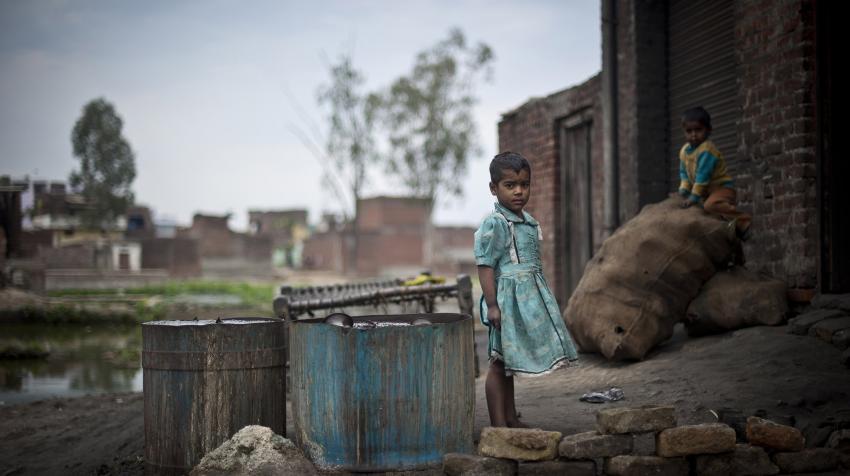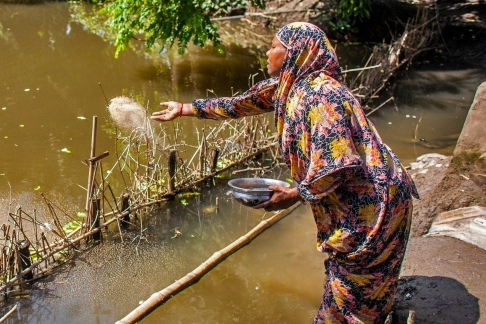While pre-pandemic global poverty rates had been cut by more than half since 2000, the COVID-19 pandemic could increase global poverty by as much as half a billion people, or 8% of the total human population. In April 2020, the United Nations issued a framework for the immediate socio-economic response to COVID-19 and created the Secretary-General's UN COVID-19 Response and Recovery Fund. Before the pandemic, significant progress had been made in alleviating poverty in many countries within Eastern and Southeastern Asia, but up to 42 per cent of the population in Sub-Saharan Africa continued to live below the poverty line.
What is Poverty?
Poverty entails more than the lack of income and productive resources to ensure sustainable livelihoods. Its manifestations include hunger and malnutrition, limited access to education and other basic services, social discrimination and exclusion, as well as the lack of participation in decision-making. In 2015, more than 736 million people lived below the international poverty line. Around 10 per cent of the world population (pre-pandemic) was living in extreme poverty and struggling to fulfil the most basic needs like health, education, and access to water and sanitation, to name a few. There were 122 women aged 25 to 34 living in poverty for every 100 men of the same age group, and more than 160 million children were at risk of continuing to live in extreme poverty by 2030.
Poverty facts and figures
- According to the most recent estimates, in 2015, 10 percent of the world’s population or 734 million people lived on less than $1.90 a day.
- Southern Asia and sub-Saharan Africa are expected to see the largest increases in extreme poverty, with an additional 32 million and 26 million people, respectively, living below the international poverty line as a result of the pandemic.
- The share of the world’s workers living in extreme poverty fell by half over the last decade: from 14.3 per cent in 2010 to 7.1 per cent in 2019.
- Even before COVID-19, baseline projections suggested that 6 per cent of the global population would still be living in extreme poverty in 2030, missing the target of ending poverty. The fallout from the pandemic threatens to push over 70 million people into extreme poverty.
- One out of five children live in extreme poverty, and the negative effects of poverty and deprivation in the early years have ramifications that can last a lifetime.
- In 2016, 55 per cent of the world’s population – about 4 billion people – did not benefit from any form of social protection.
Poverty and the Sustainable Development Goals
Ending poverty in all its forms is the first of the 17 Sustainable Development Goals (SDGs) of the 2030 Agenda for Sustainable Development.
The SDGs’ main reference to combatting poverty is made in target 1.A: “Ensure significant mobilization of resources from a variety of sources, including through enhanced development cooperation, in order to provide adequate and predictable means for developing countries, in particular least developed countries, to implement programmes and policies to end poverty in all its dimensions.”
The SDGs also aim to create sound policy frameworks at national and regional levels, based on pro-poor and gender-sensitive development strategies to ensure that by 2030 all men and women have equal rights to economic resources, as well as access to basic services, ownership and control over land and other forms of property, inheritance, natural resources, appropriate new technology and financial services, including microfinance.
Measuring Poverty
There has been marked progress in reducing poverty over the past decades. According to the most recent estimates, in 2015, 10 per cent of the world’s population lived at or below $1.90 a day. That’s down from 16 per cent in 2010 and 36 per cent in 1990. This means that ending extreme poverty is within our reach. However, the decline has slowed. In April 2013, the World Bank set a new goal to end extreme poverty in a generation. The new target is to have no more than 3 per cent of the world’s population living on just $1.90 a day by 2030. By measuring poverty we learn which poverty reduction strategies work, and which ones do not. Poverty measurement also helps developing countries gauge program effectiveness and guide their development strategy in a rapidly changing economic environment.
Global Action
The 2030 Agenda for Sustainable Development promises to leave no one behind and to reach those furthest behind first. Meeting this ambitious development agenda requires visionary policies for sustainable, inclusive, sustained and equitable economic growth, supported by full employment and decent work for all, social integration, declining inequality, rising productivity and a favorable environment. In the 2030 Agenda, Goal 1 recognizes that ending poverty in all its forms everywhere is the greatest global challenge facing the world today and an indispensable requirement for sustainable development.
While progress in eradicating extreme poverty has been incremental and widespread, the persistence of poverty, including extreme poverty remains a major concern in Africa, the least developed countries, small island developing States, in some middle-income countries, and countries in situations of conflict and post-conflict countries. In light of these concerns, the General Assembly, at its seventy-second session, decided to proclaim the Third United Nations Decade for the Eradication of Poverty (2018–2027). The objective of the Third Decade is to maintain the momentum generated by the implementation of the Second United Nations Decade for the Eradication of Poverty (2008-2017) towards poverty eradication. Further, the 3rd Decade is also expected to support, in an efficient and coordinated manner, the internationally agreed development goals related to poverty eradication, including the Sustainable Development Goals.
Department of Economic and Social Affairs (DESA)
In 1995, the World Summit for Social Development held in Copenhagen, identified three core issues: poverty eradication, employment generation and social integration, in contributing to the creation of an international community that enables the building of secure, just, free and harmonious societies offering opportunities and higher standards of living for all.
Within the United Nations system, the Division for Social Policy and Development (DSPD) of the Department of Economic and Social Affairs (DESA) acts as Focal Point for the United Nations Decade for the Eradication of Poverty and undertakes activities that assist and facilitate governments in more effective implementation of the commitments and policies adopted in the Copenhagen Declaration on Social Development and the further initiatives on Social Development adopted at the 24th Special session of the General Assembly.
International Day for the Eradication of Poverty
Through resolution 47/196 adopted on 22 December 1992, the General Assembly declared 17 October as the International Day for the Eradication of Poverty.
The observance of the International Day for the Eradication of Poverty can be traced back to 17 October 1987. On that day, over a hundred thousand people gathered at the Trocadéro in Paris, where the Universal Declaration of Human Rights was signed in 1948, to honour the victims of extreme poverty, violence and hunger. They proclaimed that poverty is a violation of human rights and affirmed the need to come together to ensure that these rights are respected. These convictions are inscribed on a commemorative stone unveiled that day. Since then, people of all backgrounds, beliefs and social origins have gathered every year on October 17th to renew their commitment and show their solidarity with the poor.
Resources
- What We Do: Promote Sustainable Development
- Sustainable Development Goal 1: No Poverty
- Department of Economic and Social Affairs
- The 2022 Global Multidimensional Poverty Index (MPI)
- World Bank: Understanding Poverty
- International Movement ATD Fourth World
- International Day for the Eradication of Poverty


